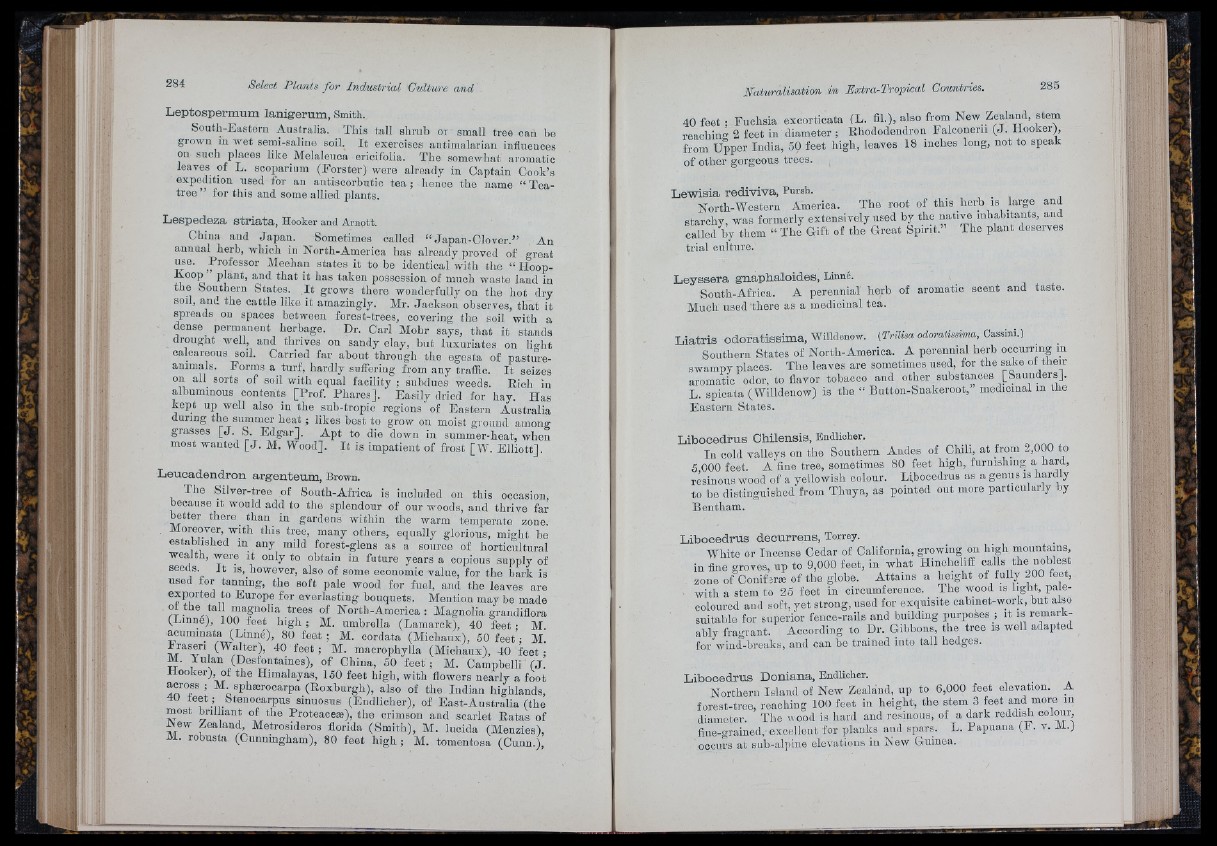
I i
i '
Leptospermum lanigerum, Smith.
South-Eastern Australia. This tall shrub or small tree can be
grown in wet semi-saline soil. I t exercises antimalarian influences
on such places like Melaleuca erioifolia. The somewhat aromatic
leaves of L. scoparium (Forster) were already in Captain Cook’s
expedition used for an antisoorbntic tea ; lience the name “ Tea-
tree ” for this and some allied plants.
Lespedeza striata, Hooker and Arnott.
China aud Japan. Sometimes called “ Japan-Clover.” An
annual herb, which in North-Ameriea has already proved of great
use. Professor Meehan states it to be identical with the “ Hoop-
Koop plant, and that it has taken possession of much waste land in
the Southern States. I t grows there wonderfully on the hot dry
soil, and the cattle like it amazingly. Mr. Jackson observes, th a t it
spreads on spaces between forest-trees, covering the soil with a
dense permanent herbage. Dr. Carl Molir says, th a t it stands
drought well, and thrives on sandy clay, bnt luxuriates on liuht
calcareous soil. Carried fa r about through the egesta of pasture-
animals. Forms a turf, hardly suffering from any traffic. It seizes
on all sorts of soil with equal facility ; subdues weeds. Rich in
albuminous contents [Prof. Phares]. Easily dried for hay. Has
kept up well also in the sub-tropic regions of Eastern Australia
during the summer heat ; likes best to grow on moist ground amouu
grasses [ J . S. Ed g ar], Apt to die down in summer-heat, when
most wanted [ J . M. Wood]. I t is impatient of frost [W. Ellio tt],
Leuoadendron argenteum, Brown.
The Silver-tree of South-Africa is included on this occasion,
because it would add to the splendour of our woods, and thrive far
better there than in gardens within the warm temperate zone.
Moreover, with tins tree, many others, equally glorious, might be
established in any mild forest-glens as a source of horticultural
wealth, were it only to obtain in future years a copious supply of
seeds. I t is,_however, also of some economic value, for the bark is
used for tanning, tbe soft pale wood for fuel, and the leaves are
exported to Europe for everlasting bouquets. Mention may be made
?C 1“® tall magnolia trees of North-Ameriea : Magnolia grandiflora
(Lmne), i 00 feet h ig h ; M. umbrella (Lamarck), 40 fe e t; M.
acuminata (Linné), 80 feet ; M. cordata (Michaux), 50 feet ; M.
Ir a s e ri (Waiter), 40 feet ; M. macrophylla (Michaux), 40 feet ;
M. Yulan (Desfontaines), of China, 50 feet ; M. Cainpbelli (J .
Jlooker), of the Himalayas, 150 feet high, with flowers nearly a foot
across ; M. sphærocarpa (Roxburgh), also of the Indian highlands,
teet ; istenooarpus sinuosus (Endlicher), of East-Australia (the
most brilliant of the Proteaceæ), the crimson and scarlet Eatas of
New Zealand Metrosideros florida (Smith), M. lucida (Menzies),
M. robusta (Cunningham), 80 feet high ; M. tomentosa (Cunn.)
40 feet ; Fuchsia excorticata (L. fil.), also from New Zealand, stem
reaching 2 feet in diameter ; Rhododendron Falconerii (J . Hooker),
from Upper India, 50 feet high, leaves 18 mches long, not to speak
of other gorgeous trees.
L ew is ia r e d iv iv a , Pursh.
North-Western America. The root of this herb is large and
starchy, was formerly extensively used by the native mliabitants, and
called by them “ The Gift of the Great Spirit. The plant deserves
trial culture.
L e y s s e r a g n a p h a lo id e s , Linné.
South-Africa. A perennial herb of aromatic scent and taste.
Much used there as a medicinal tea.
L i a t r i s o d o r a ti s s im a , Willdenow. (Trilisa. odoratissima, Cassini.)
Southern States of North-America. A perennial herb occurring in
swampy places. The leaves are sometimes used, for the sake of their
aromatic odor, to flavor tobacco and other substances [SaundersJ.
L. spicata (Willdenow) is the “ Button-Snakeroot,’ medicinal m the
Eastern States.
L ib o o e d r u s C h ile n s is , Endlicher.
In cold valleys on the Southern Andes of Chili, at from 2,000 to
5 000 feet. A fine tree, sometimes 80 feet high, furnishing a
resinous wood of a yellowish colour. Hbocedrus as a genus is hardly
to be distinguished from Thuya, as pointed out more particularly by
Bentham.
L ib o o e d r u s d e c u r r e n s , Torrey.
White or Incense Cedar of California, growing on high mountains,
in fine groves, np to 9,000 feet, in what Hinchclifl calls the noblest
zone of Coniferæ of the globe. Attains a height of fully 200 feet,
with a stem to 25 feet in circumference. The wood is light, pale-
coloured aud soft, yet strong, used for exquisite cabinet-work, but also
suitable for superior fence-rails and building purposes ; it is remark-
ably fragiant. According to Dr. Gibbons, tbe tree is well adapted
for wind-breaks, and can be trained into tall hedges.
L ib o o e d r u s D o n ia n a , Endlicher.
Northern Island of Now Zealand, up to 6,000 feet elevation. A
forest-tree, reaching 100 feet in height, the stem 3 feet and more in
diameter. Tlie «ood is hard and resinous, of a dark reddish colour
fine-grained, excellent for planks aud spars. L. Papuana (F. v. M.)
occurs at suh-alpiiie elevations iu New Guinea.
i